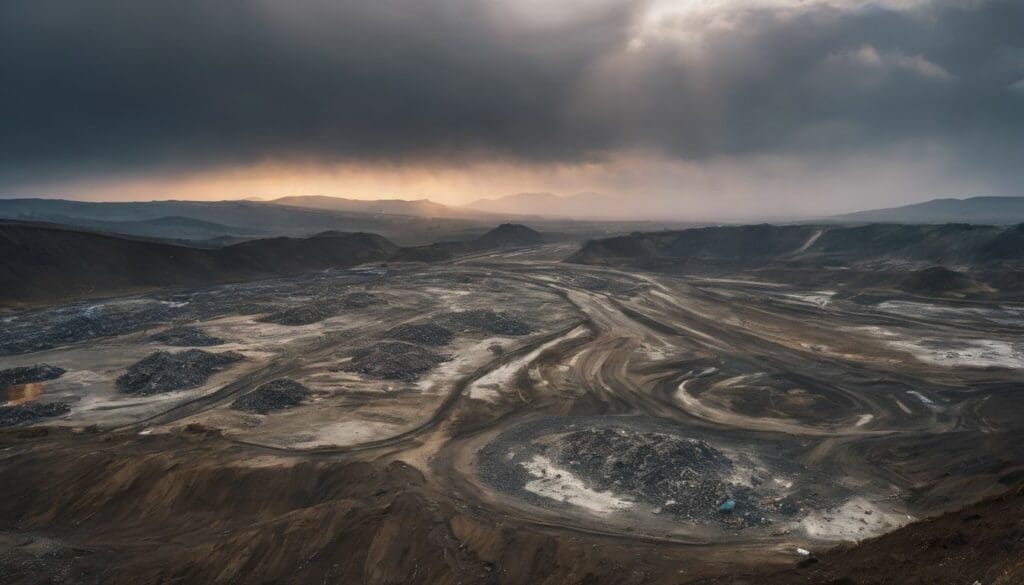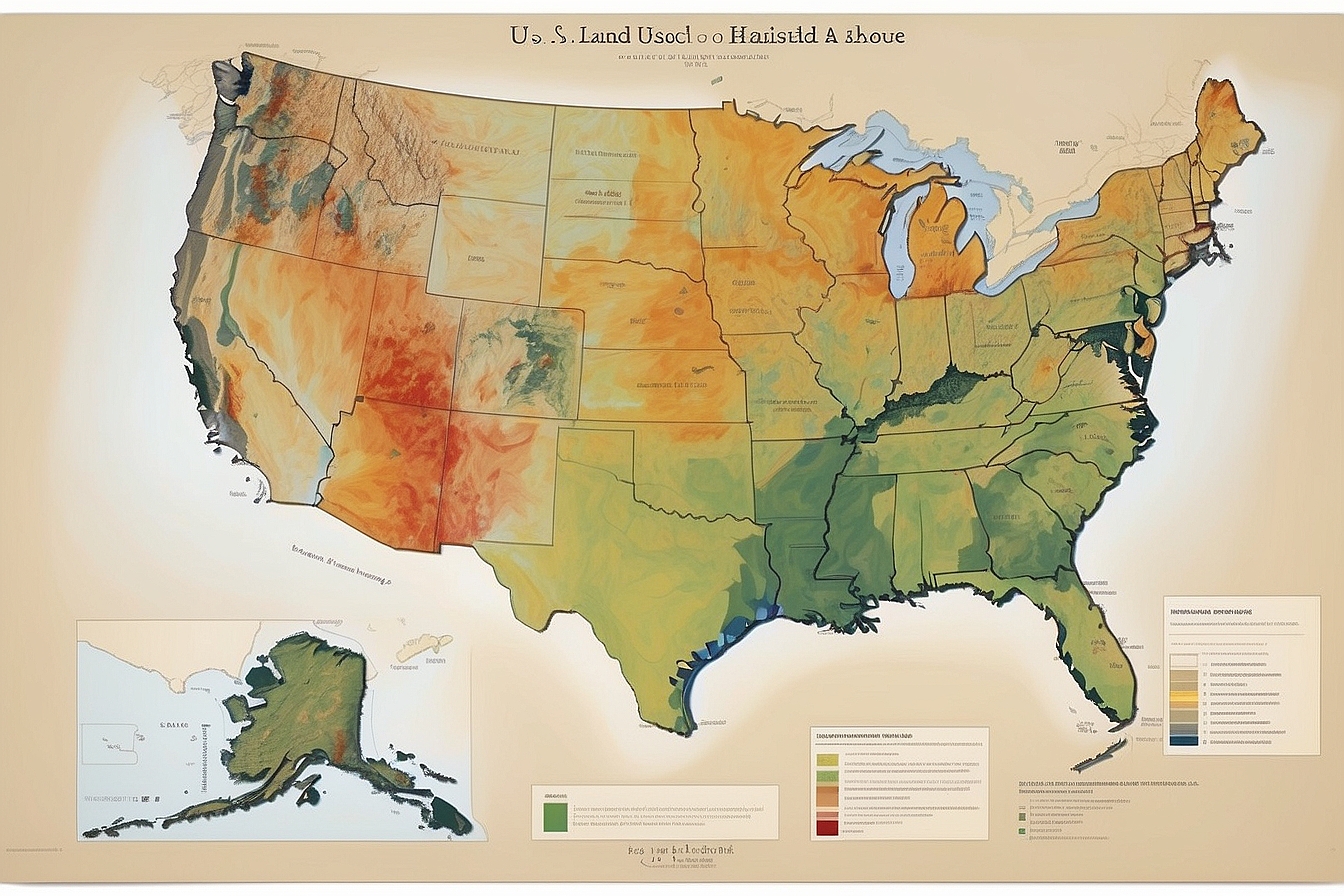We’re all guilty of it, aren’t we? Chucking our waste away without a second thought as to where it might end up. But when you think about it, the impact is rather alarming—our throw-away habits might well be wreaking havoc underfoot.
Did you know that the legacy of just one landfill site can linger in the soil for an age? It’s true. Our team has been on a bit of a mission to delve into this topic and suss out how we can lessen these enduring effects.
Stick with us – there’s light at the end of the tunnel for reviving our soils yet!
Key Takeaways
- Landfills leak harmful substances through leaching, contaminating soil and water with dangerous chemicals and heavy metals that affect human health and ecosystems.
- The presence of non – biodegradable waste in landfills alters soil composition and fertility, hindering plant growth, damaging farmlands, and potentially reducing property values.
- Greenhouse gas emissions from decomposing waste contribute to climate change; improved waste management like recycling can reduce these effects significantly.
- Implementing proper waste segregation practices, encouraging recycling initiatives, composting organic matter, and adopting alternative landfill solutions such as anaerobic digestion help protect soil quality.
- Closed – loop manufacturing processes promote a sustainable approach to resource use by focusing on recyclability and reuse within production cycles.
Negative Effects of Landfills on Soil
Landfills have negative effects on soil, including contamination of soil and water, alteration of soil composition and fertility, reduction in land value, and contribution to climate change.
These long-term impacts can have detrimental effects on the environment and public health.
Contamination of soil and water
We see the impact of landfills on our precious soil and water as they slowly poison these vital resources. Hazardous waste, often found in piles of rubbish, leaks toxic substances into the ground.
This process is known as leaching. As rainwater filters through waste material, it picks up dangerous chemicals and heavy metals along its journey. Eventually, this contaminated water seeps into nearby soil and can reach groundwater supplies.
Our concern grows when thinking about how this pollution affects ecosystems and human health alike. Soil degradation due to landfill contaminants disrupts plant growth and can render farmlands infertile.
The polluted run-off from contaminated lands flows into rivers and lakes, jeopardising aquatic life and the wellbeing of communities relying on these water sources for drinking, bathing, and farming.
It’s clear we must address these pressing environmental impacts before they irreversibly harm our ecosystem balance.
Alteration of soil composition and fertility
Landfills impact soil composition and fertility as they introduce non-biodegradable materials, altering the natural balance of nutrients essential for plant growth. Plastic pollution from landfills can lead to a decrease in soil fertility, hindering the ability of plants to absorb necessary nutrients.
Decomposition of waste in landfills affects soil composition by releasing harmful chemicals into the ground that further degrade its quality, impacting its ability to support plant life.
Furthermore, landfill leachate, which is the liquid that drains or “leaches” from a landfill, can contaminate nearby soils with toxic substances and heavy metals, further disrupting natural nutrient cycles.
Reduction in land value
As a result of alteration of soil composition and fertility, land value may decrease significantly. Contaminants and emissions from landfills can compromise the quality of the surrounding environment, which in turn leads to reduced property values.
This can have a detrimental impact on local communities and ecosystems.
Furthermore, the potential health risks associated with living near contaminated land can further devalue affected areas. It is crucial for environmentally conscious individuals to be aware of these long-term effects and take action to address them proactively.
Contribute to climate change
Landfills contribute to climate change through the release of greenhouse gases, such as methane and carbon dioxide. As organic waste decomposes in landfills, it produces methane, a potent greenhouse gas that is significantly more effective at trapping heat in the atmosphere than carbon dioxide.
The generation of these gases from landfills contributes to global warming and exacerbates climate change impacts.
Furthermore, the transportation of waste materials to landfills also leads to increased fuel consumption and emissions of air pollutants which further worsen the impact on our environment.
How to Reduce the Long-Term Effects of Landfills on Soil
Implementing recycling and recovery methods is key to reducing the long-term effects of landfills on soil. Discover more ways to protect the environment by reading the full article.
Proper waste management
Proper waste management is essential in reducing the long-term effects of landfills on soil. By separating and disposing of different types of waste correctly, we can prevent soil contamination and groundwater pollution.
Implementing recycling initiatives allows for the reutilisation of materials, minimising waste sent to landfills. Furthermore, through composting organic waste, we can enhance soil fertility and reduce the extent of landfill usage.
Introducing regulatory measures and raising awareness about responsible waste disposal are crucial in mitigating the detrimental impacts of landfills on soil health. Implementing advanced odour control systems at landfill sites prevents unpleasant smells from affecting nearby communities while safeguarding air quality.
Implementing recycling and recovery methods
To further mitigate the long-term effects of landfills on soil, implementing recycling and recovery methods is crucial. By diverting recyclable materials from landfills, we can reduce the volume of waste being deposited in these sites.
This approach not only lessens the physical footprint of landfills but also minimises groundwater contamination and methane emissions by reducing the amount of organic waste decomposing within them.
Embracing recovery methods such as composting and bioenergy production also helps to extract value from organic matter that would otherwise contribute to soil degradation and greenhouse gas emissions.
Alternative solutions to traditional landfills
Implementing recycling and recovery methods is crucial, but alternative solutions to traditional landfills can further mitigate the long-term effects on soil. One such solution is the adoption of anaerobic digestion, a process that converts organic waste into biogas and biofertiliser.
By diverting organic waste from landfills, this method reduces methane emissions and creates renewable energy sources. Additionally, incineration with energy recovery can be used to convert non-recyclable waste into electricity or heat, minimising the volume of landfill-bound materials.
These alternatives not only address the environmental concerns associated with traditional landfills but also contribute towards creating a more sustainable approach to waste management.
Introducing closed-loop manufacturing processes promotes product redesign for recyclability while encouraging reusing materials in production cycles. This circular economy model minimises resource consumption and diminishes waste generation at its source.
Furthermore, innovative technologies like plasma gasification break down disposed materials at high temperatures without oxygen, producing recoverable gases and inert solid residues suitable for construction materials.
Conclusion
In conclusion, we must address the negative impact of landfills on soil. Contamination and altered composition degrade soil quality. Reduction in land value affects communities. Proper waste management and alternative solutions are crucial to minimise long-term effects.
We must act now to protect our environment for future generations.
FAQs
1. What happens to the soil around landfills in the long term?
Over time, landfills can lead to land degradation due to the buildup of waste, affecting the soil’s health and possibly releasing harmful landfill gases that hinder biodegradation.
2. Does a landfill have any effect on our health?
Yes, living near a landfill site may expose people to various health effects due to the release of landfill gas and toxins that come from waste breakdown.
3. Can anything be done about smells coming from landfills?
Absolutely! Odor control measures can be implemented at landfills to reduce unpleasant smells caused by decomposing waste and help maintain air quality for nearby communities.
4. How does biodegradation play a role in landfills’ effects on soil?
Biodegradation is important as it helps break down organic material in landfills; however, when slowed or disrupted, this process leads to increased longevity of waste impact on soil quality and structure.





